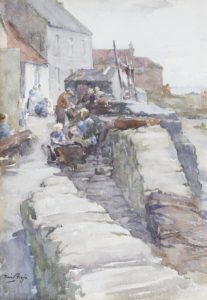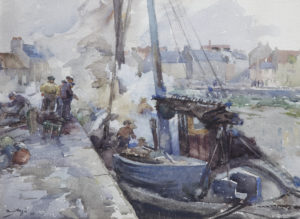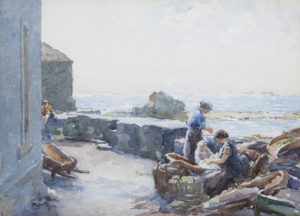The Recording Scotland collection is a set of watercolours, oils and prints collected during the second world war to permanently capture the “feeling” of the nation. Each piece of artwork was chosen because it captured an essential view of Scotland; with emphasis on the places most likely threatened by war and industrialisation. This is the eighth blog in the series of blogs about different aspects of the Recording Scotland Collection.

Today we would like to introduce a nautical theme from the Recording Scotland Collection, featuring images of both women and men at work in the fishing industry before and between the world wars.
Only a dozen of the Recording Scotland Collection paintings capture such scenes of boats, harbours, and the men and women who made their livelihoods by the ocean. This is a relatively small number of paintings when we consider that Scotland has a mainland coastline that spans over 6,000 miles and, when you include the islands it reaches over 10,000 miles of shoreline! That is a magnificent amount of coast, and thousands of stories to tell about the fishing villages and their inhabitants.
David Foggie RSA (1878-1948) is the artist that provides several of the coastal paintings we are featuring today. He trained in Dundee and furthered his artistic studies in Belgium. He returned home to Scotland in 1904 and settled in Fife, near Leuchars. His paintings of Pittenweem help to illustrate the cultural traditions of East Neuk and East Lothian fishing villages, and particularly highlights the role that women played in the fishing industry.
In 1907, 2,500,000 barrels of herring were salted and shipped from Scotland. This “boom” of herring resulted in thousands of vessels, fishermen and “herring lasses” being employed. Government support and the use of railways for shipping had resulted in a robust industry as long as the fish shoals were healthy. This boom was a high mark for the fishing industry, but it was soon to face the challenges of two world wars and a changing global economy. For centuries, Scotland had been the location best suited for fishing for salmon and herring and had resulted in a thriving trade with European neighbours.

Herring was traditionally caught using a drift net. These nets were stretched out and suspended in the water by corks, where the fish become trapped by their gills when they try to swim into the net. Drift nets had to be constantly repaired and treated, in a process called “barking and drying.” We can see the fishermen at work with their nets in the paintings by David Foggie called Barking nets, Pittenweem and West Shore, Pittenweem. The nets had to be submerged in large pots on shore every few weeks during the fishing season, whereas wealthier and more advanced vessels could treat their nets aboard ship. The nets were then stretched out on grassy hills, long gardens, alleyways or shores to dry before being used again. The historic villages still have long and unusually shaped buildings reflecting the need for nets to dry and ropes to be made.
Fishing was a family affair. We can imagine the work performed by the women captured in May Marshall Brown’s Cat Row, Dunbar and we can see the women seated by their homes in West Shore, Pittenweem. Women would work by cleaning fishing lines, reattaching, and baiting new hooks before each journey to sea. They could gather with other women while they did the work, while also minding their children and a thousand other tasks. If the women were busy handling fish guts, you can imagine how many cats came to beg for their dinner.
Scottish women had limited access to occupations at the end of the 1800s, but seasonal work around herring fishing provided a much-needed income. Women travelled from the islands to the mainland and back, even venturing south to England following the shoals of herring. Teams of women worked together gutting and packing the herring into barrels for days on end. Most could gut fish at a rate of 30 to 50 a minute. The work was hard and dangerous, due to the high probability of cuts and infections. The women were paid at the end of the season based on the number of barrels they were able to pack. This might result in receiving £10 – £20 for the season if it was a prosperous year. If it was a poor fishing season, then they might only make enough money to travel home. The women understood the work to be hard but enjoyed the companionship and extra income that it afforded them. It also gave them the opportunity to visit new villages and ports, and potentially make romantic matches. Women’s Work, Pittenweem captures this communal effort as the women work on the shore.

Salted herring was purchased predominately by Germany, the Baltic nations, and Russia in the early part of the 20th century. All countries that were severely impacted at the outbreak of war and suffered from inflation and economic instability. In the 1930s, other countries also built up their own domestic fishing fleets and no longer relied on the Scottish trade. During the wars, men went off to military service and women had transitioned into munitions work or nursing. Technology also advanced for fishermen who could do more with smaller, more efficient boats and packing facilities. Tastes also changed, and salted herring was no longer as prized as other types of seafood. Fishermen (and women) continue to adapt in the coastal villages and find new and inventive ways to continue the traditions of their trade. It was once popular to present friends and neighbours with a string of herring as a gift. When was the last time you gave someone a herring?
The various roles that women have performed in Scottish maritime history have not only been captured in paint, but also in bronze. The “herring girls” are commemorated with two statues in Stornoway on the Isle of Lewis and a statue of a woman and child stand in Pittenweem harbour looking out to sea in remembrance of the 400 people who have lost their lives at sea.
To learn more about the history of fishing in Scotland, make sure to stop in at the Scottish Fisheries Museum in Anstruther.